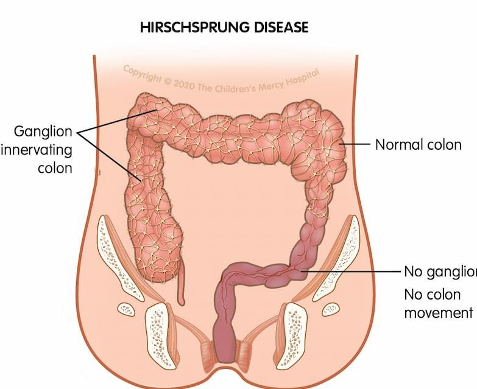Which assessment finding should the nurse expect in an infant with Hirschsprung disease?
Constipation with passage of foul-smelling, ribbon-like stools
Diarrhea
Foul-smelling, fatty stools
"Currant jelly" stools
The Correct Answer is A
The assessment finding that the nurse should expect in an infant with Hirschsprung disease is option A, constipation with the passage of foul-smelling, ribbon-like stools. Hirschsprung disease is a congenital condition characterized by the absence of ganglion cells in the distal part of the colon, leading to functional obstruction. The affected segment of the colon lacks the normal peristaltic movements, resulting in an accumulation of faecal matter. The stools passed by infants with Hirschsprung disease are often constipated, and the narrow, ribbon- like appearance is a result of the narrowed segment of the colon.
diarrhea (option B) is incorrect because it, is not typically associated with Hirschsprung disease. Instead, the condition presents with constipation due to the obstructed bowel.
foul-smelling, fatty stools in (option C) is incorrect because it, is not characteristic of Hirschsprung disease. This finding may be associated with malabsorption disorders such as cystic fibrosis or celiac disease, but not specifically with Hirschsprung disease.
"currant jelly" stools in (option D) is incorrect because it, is a term commonly used to describe the stools seen in intussusception, which is a different condition involving the telescoping of one segment of the bowel into another. It is not an expected finding in Hirschsprung disease.

Nursing Test Bank
Naxlex Comprehensive Predictor Exams
Related Questions
Correct Answer is A
Explanation
Graves' disease is an autoimmune disorder that affects the thyroid gland and results in the overproduction of thyroid hormones. Treatment for Graves' disease typically involves medications to regulate thyroid function. Adherence to the medication regimen is crucial for managing the disease and controlling symptoms.
By prioritizing the goal of verbalizing the importance of adherence to the medication regimen, the nurse aims to educate the adolescent about the significance of taking medications as prescribed. This education can help the adolescent understand the impact of medication non-adherence on their health and encourage them to actively participate in their treatment.
, developing alternative educational goals in (option B) is incorrect because it, is not directly related to the management of Graves' disease and its treatment.
allowing the adolescent to make decisions about whether or not to take medication in (option C) is incorrect because it, is not appropriate for a condition like Graves' disease where medication adherence is necessary for disease management. In this case, the nurse should focus on providing education and support to help the adolescent understand the importance of medication compliance.
relieving constipation in (option D) is incorrect because it, may be a consideration if constipation is a symptom experienced by the adolescent with Graves' disease. However, it is not the priority nursing goal as compared to ensuring adherence to the medication regimen, which directly addresses the management of Graves' disease.
Correct Answer is C
Explanation
The most important factor in determining the rate of fluid replacement in a dehydrated child
is urine output. Urine output is a crucial indicator of renal perfusion and hydration status.
Monitoring urine output allows healthcare professionals to assess the child's response to fluid
replacement therapy and adjust the rate accordingly.
The type of dehydration in (Option A) is incorrect. The type of dehydration, is important in
determining the appropriate fluid composition for rehydration but does not directly dictate the
rate of fluid replacement.
The child’s weight in (Option B) is incorrect. The child's weight, is considered when
calculating the maintenance fluid requirements, but it does not solely determine the rate of
fluid replacement for dehydration.
Serum potassium level in (Option D) is incorrect. The serum potassium level, is important to
monitor in a dehydrated child, especially in cases of severe dehydration, as electrolyte
imbalances may occur. However, it is not the most important factor in determining the rate of
fluid replacement. Fluid replacement is primarily guided by assessing the child's hydration
status through parameters such as urine output and clinical assessment.
Whether you are a student looking to ace your exams or a practicing nurse seeking to enhance your expertise , our nursing education contents will empower you with the confidence and competence to make a difference in the lives of patients and become a respected leader in the healthcare field.
Visit Naxlex, invest in your future and unlock endless possibilities with our unparalleled nursing education contents today
Report Wrong Answer on the Current Question
Do you disagree with the answer? If yes, what is your expected answer? Explain.
Kindly be descriptive with the issue you are facing.
